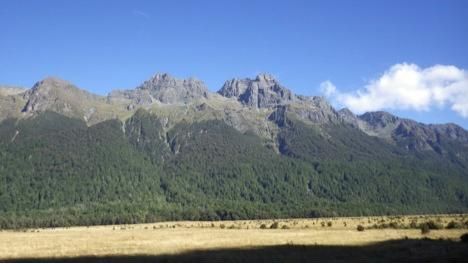
Smithsonian Journeys to Milford Sound, South Island, New Zealand
Tom Iliffe
Milford Sound is a 15 km long fiord that opens into the Tasmanian Sea from the southwest coast of New Zealand's South Island. It lies within Fiordland National Park, Piopiotahi (Milford Sound) Marine Reserve, and the Te Wahipounamu World Heritage site. Among other superlatives, it has been rated the world's top travel destination, acclaimed as New Zealand's most famous tourist destination, and called by Rudyard Kipling the eighth Wonder of the World.
Milford Sound, which was originally shaped by the actions of glaciers, is actually an ocean inlet rather than a sound, since it is larger than a bay, deeper than a bight, and wider than a fjord. It is surrounded by sheer cliffs and high mountain peaks on all sides.

A highlight of our Smithsonian Journeys tour of the Natural Wonders of Australia and New Zealand (February 7-21, 2015) was our trip to Milford Sound. We began with an early morning departure by bus from our hotel in Queenstown for the approximately 4 hour drive to Milford Sound. The latter part of this drive was through the spectacular scenery of Fiordland National Park, along the shore of Lake Te Anau. Although this large, glacier-carved lake is at an elevation of 210 m, it has a maximum depth of 414 m, such that much of the lake bed is actually below sea level. Due to this, Lake Te Anau is the largest lake in Australasia in terms of fresh water volume. Past the northern tip of the lake, vistas opened up to grassy meadows, bounded by lushly forested slopes that ascended to rocky peaks.

In order to cross the mountains to Milford Sound, our tour bus wound its way up to near the summit of snowcapped peaks where the 1.2 km long Homer Tunnel cuts through the mountain range. After exiting the tunnel and working our down through a series of switchbacks to the lower slopes of the mountain, the vegetation changed dramatically to a verdant forest of fern trees and clear, fast flowing streams.
At last we reached Milford Sound, where upon my first glimpse, I was hugely impressed on how little the magnificent scenery had changed in the more than 200 years since its initial discovery by Europeans in 1812. This remote and still pristine area was initially bypassed by early explorers such as Capt. James Cook since its narrow entrance from the sea did not appear to lead into large interiors bays. The literal centerpiece of our view of the Sound proved to be a stunning sight, the mile high Mitre Peak (named due to its resemblance in shape to that of a bishop’s mitre or head-dress).

Along the Sound, we cruised past a multitude of magnificent waterfalls, several of which plummeted out of elevated U-shaped glacial valleys. After exiting the Sound and turning around in the ocean for our return trip, we came back to Stirling Falls for a closer look, actually poking the bow of the ship under the clouds of spray tumbling down from above! The final highlight of the cruise was the sighting of a pod of seals sleeping on the rocks as waves from our ship washed by.
But the best treat had been saved for last! After disembarking from the boat, we headed over to the nearby airport for a flight on small planes back to Queenstown. We were incredibly lucky with the weather on this trip having clear skies, spectacular vistas and a smooth flight home. I was fortunate enough to land the copilots seat in the front of the plane and thus had magnificent views as we flew over the ice clad mountains of Middle Earth. It was easy to see why Fiordland National Park was chosen for the epic shots of magnificent scenery used in The Hobbit and The Lord of the Rings Trilogies!
All in all, one of the most enjoyable days that I have had in a long time!

/https://tf-cmsv2-journeys-media.s3.amazonaws.com/journeys/catalog/cover_image/Mar_24_SJ_Cover.jpg)
 Be the First to Know
Be the First to Know